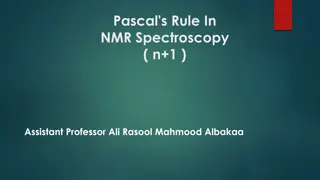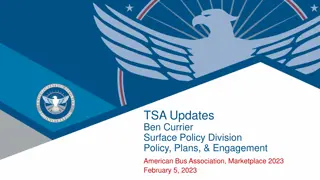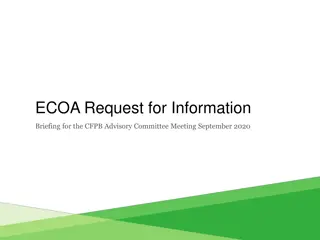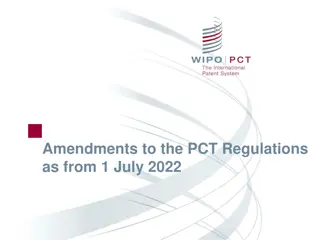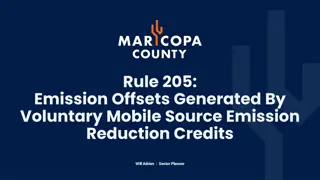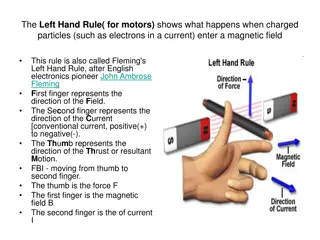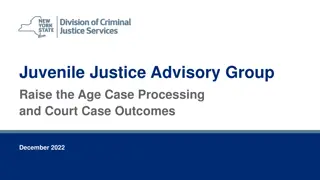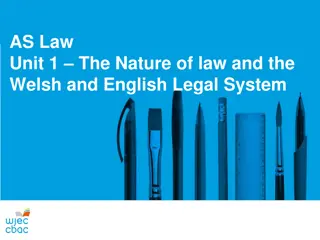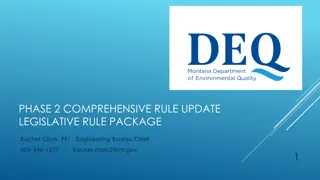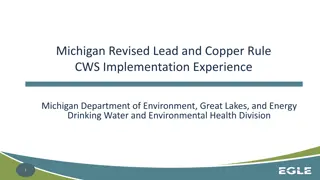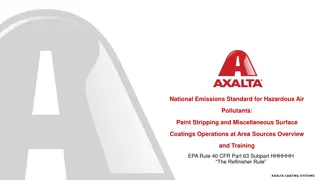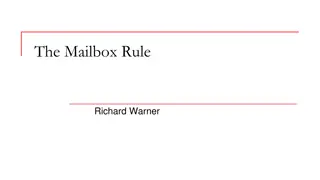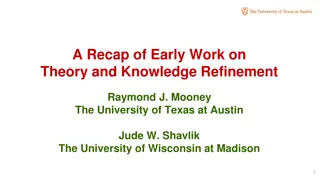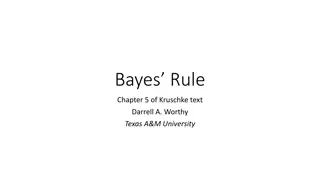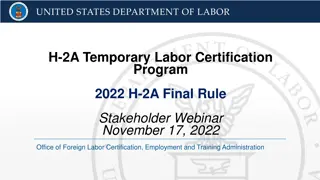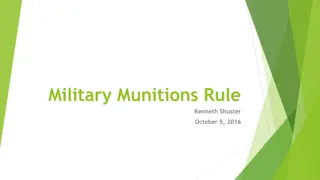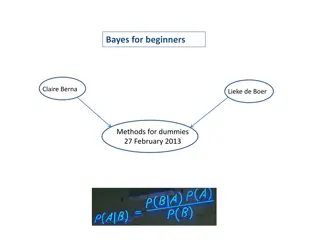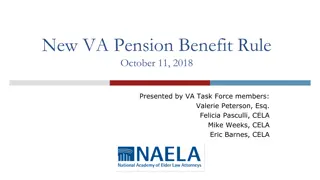
Key Highlights of CFPB Final Debt Collection Rule Part 2
Discover crucial details about the CFPB Final Debt Collection Rule Part 2, including effective dates, modified definitions, statute of limitations, and prohibited practices. Learn about important regulations that debt collectors must adhere to before the rule's implementation on November 30, 2021.
Download Presentation

Please find below an Image/Link to download the presentation.
The content on the website is provided AS IS for your information and personal use only. It may not be sold, licensed, or shared on other websites without obtaining consent from the author. If you encounter any issues during the download, it is possible that the publisher has removed the file from their server.
You are allowed to download the files provided on this website for personal or commercial use, subject to the condition that they are used lawfully. All files are the property of their respective owners.
The content on the website is provided AS IS for your information and personal use only. It may not be sold, licensed, or shared on other websites without obtaining consent from the author.
E N D
Presentation Transcript
CFPB Final Debt Collection Rule Part 2
All parts of the Rule become effective on one date: November 30, 2021. Debt collectors may comply with requirements and prohibitions in the final rule before the effective date. BUT NOTE: Until the effective date, the FDCPA and other applicable law continue to govern the conduct of debt collectors. AND ALSO: Safe harbors established in the final rule are not effective until November 30, 2021. (See. pp. 266-67.) Effective Date
Modified definition of Consumer to clarify that it includes Deceased natural persons. See 1006.2 (e). Definitions
Statute of Limitations means the period prescribed by applicable law for bringing a legal action against the consumer to collect a debt. Time Barred Debt means a debt for which the applicable statute of limitations has expired. Time Barred Debts Debt collector prohibited from bringing or threatening to bring a legal action against a consumer to collect a time-barred debt. Does not apply to proofs of claim filed in connection with a bankruptcy proceeding.
No federal legislative or regulatory standard Look to FTC consent decrees, Cases Law and State Law State law Disclosures in California, Connecticut, Massachusetts, New Mexico, New York (and NY City), Texas (debt buyers), West Virginia Prohibitions in Mississippi, Wisconsin, and purchased debt in North Carolina Collection of Time Barred Debts
A debt collector cannot credit report before it: Speaks to the consumer about the debt in person or by telephone; or Sends a letter, text or email and waits a reasonable period of time to receive a notice of undeliverability. Sending the Reg F model validation notice satisfies the Credit Reporting Notice Requirement. 14-day safe harbor for electronic messages and mailed letters. Other Prohibited Practices Credit Reporting Notice Requirement Section 1006.30(a)
Prohibited A debt collector cannot sell, transfer for consideration, or place for collection a debt if the collector knows or should know: (1) the debt has been paid or settled; OR (2) the debt has been discharged in bankruptcy. Other Prohibited Practices Exceptions: Transfer of debt to owner; Transfer to previous owner of debt if authorized by contract between collector and previous owner; or Transfer resulting from merger, acquisition, purchase and assumption transaction, or transfer of substantially all of a debt collector s assets.
Required to be provided to consumer by sending as part of the initial communication; sending within five days of the initiation communication; providing orally during initial communication. Notice for Validation of Debts Section 1006.34(a) Exception Not required if consumer pays prior to time that notice would be required
Key Definitions: Clear and conspicuous - "readily understandable" Notice for Validation of Debts Section 1006.34(b) Initial communication - first direct or indirect conveyance of info about debt from Debt Collector to Consumer other than formal pleading and some legal notices Itemization date -(1) last statement date; (2) charge-off date; (3) last payment date; (4) transaction date; and (5) judgment date. Validation notice - written or electronic Validation period date you provide validation information until 30 days after consumer receives or assumed to receive (assume 5 days to receive, exclude federal holidays and weekends)
VALIDATION INFORMATION: Debt collector must provide: oCommunication disclosure, i.e., mini-Miranda; oInformation about the debt; oInformation about consumer protections; oConsumer-response information; o Dispute prompts; o Original-creditor information prompt; o Mailing addresses oValidation information must be clear and conspicuous Notice for Validation of Debts Section 1006.34(c)
o Debt Collectors name and mailing address for disputes and requests for creditor info; o Consumer's name and mailing address o For consumer financial product or services, name of creditor to whom owed on itemization date; o Account number (may be truncated); o Name of current creditor; o Itemization date o Amount of debt on itemization date; o Itemization of current amount (interest, fees, payments, credits since itemization date). May provide on separate page (not reverse side). Notice for Validation of Debts - INFORMATION ABOUT THE DEBT Section 1006.34(c)(2)
SAFE HARBOR If you use Model Form B-1, you comply with the rule s validation requirements and clear-and-conspicuous requirement You may: Omit optional disclosures on Form B-1; or Add any or all optional disclosures on Form B-1. Cannot be more prominent than information required by 1006.34(c). Provide itemization on separate page if you provide a statement referring to that separate page. Notice for Validation of Debts Section 1006.34(d)(2) SUBSTANTIALLY SIMILAR FORM: You may make changes to the model form and stay within the safe harbor if "the form remains substantially similar to Model Form B 1."
Optional Disclosures Include: Telephone contact information Reference Code Payment disclosures Disclosures under applicable law Disclosures on the front or back of the notice (e.g., for time-barred debt / state required disclosures) Information about electronic communications Spanish-language translation disclosures Merchant brand, affinity brand, or facility name associated with the debt Notice for Validation of Debts Optional Disclosures Section 1006.34(d)(3)
Validation notices delivered electronically: If a debt collector delivers a validation notice electronically, it may, at its option, format the validation notice as follows: (i) Prompts. Any prompt required by paragraphs (c)(4)(i) or (ii) or (d)(3)(iii)(B) or (vi)(B) of this section may be displayed electronically as a fillable field. (ii) Hyperlinks. Hyperlinks may be embedded that, when clicked: (A) Connect a consumer to the debt collector s website; (B) Connect a consumer to the Bureau s debt collection website as disclosed pursuant to paragraph (c)(3)(iv) of this section; or (C) Permit a consumer to respond to the dispute and original- creditor information prompts required by paragraphs (c)(4)(i) and (ii). Notice for Validation of Debts Section 1006.34(d)(4)
TRANSLATIONS: Notice for Validation of Debts Section 1006.34(e) You may send a validation notice completely and accurately translated into any language if: You send the English-language validation with it (in the same communication; or You previously provided the English-language validation. If you provided either or both of the optional disclosures about Spanish-language validation notices permitted in (d)(3)(vi), then you must provide the translated validation notice completely and accurately translated into Spanish if the consumer has requested it.
Restates FDCPA 809(b) prohibition against overshadowing validation notice. Safe harbor from overshadowing if debt collector uses Model Form B-1 validation notice in a manner consistent with the rule. Disputes and Request for Original Creditor Information Section 1006.38 Special Rule for same current and original creditor: If original creditor is the same as the current creditor, debt collector may notify consumer of that fact in writing or electronically and refer consumer to the validation information previously provided.
Permits collector to respond to a dispute the collector reasonably determines is a duplicative dispute by: Disputes and Request for Original Creditor Information Section 1006.38 1. Notice: Notify the consumer in writing or electronically that the dispute is duplicative, Explain the basis for the determination, and Referring the consumer to the collector s earlier response; OR 2. Send another copy of the debt verification or judgment.
Sending Required Disclosures Section 1006.42 Required disclosures sent electronically must do so in accordance with section 101(c) of the Electronic Signatures in Global and National Commerce Act (E-SIGN Act) (15 U.S.C. 7001(c).
Exceptions to Section 1006.42(a) (E-SIGN Requirement): Does not apply to Opt-Out or mini-Miranda disclosures unless the disclosure is included on a notice required by the Validation Notice- Initial Communication or Disputes and Requests for Original-Creditor Information Sending Required Disclosures Section 1006.42 Requirements for certain disclosures sent electronically: Notices required by Validation Notice within 5 days of initial communication or Disputes and Requests for Original-Creditor Information must be sent in compliance with the E-SIGN Act



